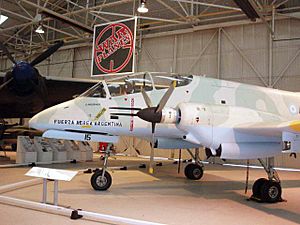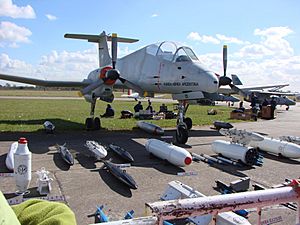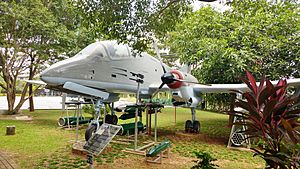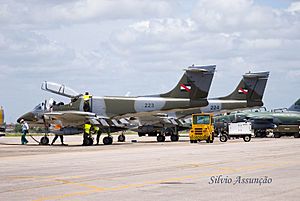FMA IA 58 Pucará facts for kids
class="infobox " style="float: right; clear: right; width: 315px; border-spacing: 2px; text-align: left; font-size: 90%;" ! colspan="2" style="text-align: center; font-size: large; padding-bottom: 0.3em;" | IA 58 Pucará |-
|- | colspan="2" style="text-align: center;" |  |- |colspan="2" style="border-bottom: 1px solid #aaa;text-align:center;" |An IA 58 Pucará of the Argentine Air Force |-
|- |colspan="2" style="border-bottom: 1px solid #aaa;text-align:center;" |An IA 58 Pucará of the Argentine Air Force |-
! Role | Counter-insurgency aircraft |- ! National origin | Argentina |- ! Manufacturer | Fábrica Militar de Aviones |-
! First flight | 20 August 1969 |- ! Introduction | May 1975 |-
! Status | In service |- ! Primary users | Argentine Air Force
Sri Lanka Air Force (historical)
Uruguayan Air Force (historical) |- ! Produced | 1974–1993 |- ! Number built | 110 |-
|}
The FMA IA 58 Pucará (which means "Fortress" in the Quechua language) is a special attack aircraft made in Argentina. It was built by the Fábrica Militar de Aviones. This plane is designed to attack targets on the ground and help fight against rebel groups.
The Pucará is a low-wing plane with two turboprop engines. It's made of metal and has landing gear that can be pulled up into the plane. It can even take off and land on rough, unprepared runways. This aircraft was used in the Falklands War and the Sri Lankan Civil War.
Contents
How the Pucará Was Developed
In August 1966, a factory in Argentina called DINFIA started working on a new plane. The Argentine Air Force needed a plane that could help fight against rebel groups. Engineer Aníbal Dreidemie led the project.
They decided to build a plane with a low wing and two turboprop engines. These engines would be placed in pods on the wings. To test their ideas, they first built a full-size glider (a plane without an engine). This glider flew for the first time in December 1967.
The glider tests showed that the design worked well. So, in September 1968, they started building a real prototype. This first powered plane was called the FMA IA 58 Delfín. Later, it was renamed Pucará. It had two Garrett TPE331 engines. The first prototype flew on August 20, 1969.
A second prototype flew in September 1970, this time with different engines called Turbomeca Astazou. These Astazou engines were chosen for the planes that would be built for the air force. The first production model, meaning the first one made for use, flew in November 1974. Deliveries to the Argentine Air Force began in early 1976.
Design of the Pucará
The IA 58 Pucará is made mostly of metal, especially a strong aluminum alloy called duralumin. Its wings are straight and have special flaps at the back to help with landing and takeoff.
The plane has a slim body and a cockpit for two crew members. They sit one behind the other under a canopy that opens upwards. Both pilots have controls, and they have a good view, especially to the front and sides. The Pucará's smooth design helps it fly quite fast, even faster than some similar planes like the American OV-10 Bronco.
Special armor plates protect the crew and engines from ground fire. The plane is powered by two Turbomeca Astazou engines. These engines turn three-bladed propellers that can also act as air brakes.
The Pucará was built to fly from short, rough airstrips. Its landing gear has a single wheel at the front and two wheels on each side. These wheels have low-pressure tires, which are good for uneven ground. The landing gear is also tall, giving plenty of space for weapons carried under the wings. For very short takeoffs, three special rockets can be attached under the plane.
The Pucará carries a lot of firepower. It has two 20 mm cannons under the cockpit, each with 270 rounds of ammunition. It also has four 7.62 mm machine guns on the sides of the fuselage, each with 900 rounds. The plane can carry bombs, rockets, or extra fuel tanks on three special points under its body and wings. The main point under the body can hold up to 1,000 kg (2,200 lb) of weapons, and the two under the wings can each hold 500 kg (1,100 lb). In total, it can carry up to 1,620 kg (3,570 lb) of external weapons.
Pucará in Action
The first Pucarás were delivered to the Argentine Air Force in May 1975. They were first used in late 1975. Pucarás flew missions from Córdoba against rebel groups in Tucumán Province.
The Falklands War (1982)

By the time of the Falklands War in 1982, Argentina had about 60 Pucarás. These planes were important because they could operate from the smaller airfields in the Falklands. Larger Argentine jets like the Skyhawks and Mirages needed longer runways.
Four Pucarás arrived at Port Stanley on April 2, 1982, and eight more arrived on April 9. Other Pucarás stayed on the mainland in southern Argentina. They were used for scouting and light attacks.
On May 1, 1982, three Pucarás were destroyed at Goose Green by bombs dropped by British Sea Harriers. Six more were destroyed during a British Special Air Service (SAS) raid on Pebble Island on May 15, 1982.
On May 21, a Pucará was shot down by a Stinger missile. Another was hit by cannon fire from a British Sea Harrier. The pilot of that Pucará, Major Carlos Tomba, survived by ejecting from the plane.
On May 28, two Pucarás shot down a British Royal Marines Scout helicopter with their machine guns. This was the only time an Argentine aircraft shot down a British aircraft in the war. One of these Pucarás crashed on its way back to Port Stanley. The pilot, Lt Miguel Gimenez, died in the crash. Also on May 28, another Pucará was shot down by small arms fire from British troops during the Battle of Goose Green. The pilot, Lt Miguel Cruzado, ejected and was captured.
Captured Pucarás
After the war, British forces captured eleven Pucarás. Four of them were still able to fly. Six of these captured planes were taken to the United Kingdom. They are now in museums or privately owned.
Sri Lankan Civil War
The Sri Lanka Air Force bought two Pucarás from Argentina in 1993. They needed planes for fighting rebel groups. These planes were very effective because they could carry a lot of weapons and fly at a good speed for close air support.
Pucarás were used for training and combat missions. One Pucará (CA-605) was hit by ground fire but managed to land safely. It is now on display at the Sri Lanka Air Force Museum. In July 1995, one Pucará (CA-601) was shot down by a portable missile, and its pilot, Flight Lieutenant Dilhan Perera, died. Another Pucará (CA-604) was destroyed in an accident during a night bombing mission.
After these losses, the last remaining Pucará (CA-602) was retired in 1997. The Pucará's main weaknesses were that it couldn't fly at very high altitudes and didn't have good defenses against missiles.
Upgrades and Modernization
Over the years, there have been several attempts to upgrade the Pucará fleet. In 1982, during the Falklands War, one prototype was even tested to carry torpedoes to attack ships.
Many upgrade projects were planned but often canceled because of a lack of money. However, the Uruguayan Air Force did update its Pucarás with better navigation systems.
In 2007, an Argentine Pucará was modified to run on bio-jet fuel made from soy. This project aimed to make the Argentine Air Force less dependent on fossil fuels.
Since 2009, the Argentine Air Force has been working on a big upgrade program called the IA-58D Pucará Delta. This involves adding new electronic systems to the cockpit and replacing the old engines with more powerful ones. The goal is to keep the Pucarás flying until 2045. In 2019, Argentina decided to change the Pucará from a combat plane to a border surveillance and patrol aircraft, calling it the Pucará Fénix. This version has new engines and a special sensor camera.
Other Countries Interested
Many other countries showed interest in buying the Pucará over the years, including Peru, Mauritania, Venezuela, Iraq, Bolivia, Iran, Congo, Brazil, and Paraguay. However, most of these deals were canceled for various reasons.
Pucará Versions
- IA-58A Pucará: This is the main production version, used for attacking ground targets and fighting rebel groups.
- IA-58B Pucará Bravo: A modified version with stronger cannons and better electronics. Only one prototype was made.
- IA-58C Pucará Charlie: A single-seat version designed after the Falklands War. It had more cannons, could carry air-to-air missiles, and had better protection. Only one prototype was built.
- IA-58D Pucará Delta: This is the current modernization program. It updates existing Pucarás with new electronic systems and more powerful engines. It is also known as IA-58H.
- IA-66: A version of the IA-58A with different, more powerful engines. Only one prototype was converted.
- IA-58 Pucará Fénix: This is the newest version, used for border surveillance and patrol. It has upgraded engines and a special sensor turret.
Who Used the Pucará
Current Operators
- "Fenix" version tested since 2019, approved in 2021.
Former Operators
- Argentine Air Force
- Colombian Air Force
- Sri Lanka Air Force (Used from 1993–1999)
- Royal Air Force (One captured Pucará was studied after the Falklands War and then given to a museum).
- Uruguayan Air Force (Retired in 2017).
Specifications
Data from Jane's Civil and Military Upgrades 1994–95
General characteristics
- Crew: two
- Length: 14.25 m (46 ft 9 in)
- Wingspan: 14.50 m (47 ft 7 in)
- Height: 5.36 m (17 ft 7 in)
- Wing area: 30.30 m2 (326.1 sq ft)
- Aspect ratio: 6.9:1
- Airfoil: NACA 642A215 at root, NACA641 at tip
- Empty weight: 4,020 kg (8,863 lb)
- Max takeoff weight: 6,800 kg (14,991 lb)
- Fuel capacity: 1,280 L (280 imp gal; 340 US gal) internal, up to 1,736 L (382 imp gal; 459 US gal) in external tanks
- Powerplant: 2 × Turbomeca Astazou XVIG turboprop, 729 kW (978 hp) each
Performance
- Maximum speed: 500 km/h (311 mph; 270 kn) at 3,000 m (9,800 ft)
- Cruise speed: 430 km/h (267 mph; 232 kn) at 6,000 ft (1,800 m) (econ cruise)
- Stall speed: 143 km/h (89 mph; 77 kn) (flaps and undercarriage down)
- Never exceed speed: 750 km/h (466 mph; 405 kn)
- Combat range: 350 km (217 mi; 189 nmi) (Combat radius with 1,500 kg (3,300 lb) weapons, High-low-high profile)
- Ferry range: 3,710 km (2,305 mi; 2,003 nmi) max internal and external fuel
- Service ceiling: 10,000 m (33,000 ft)
- g limits: +6/-3 g
- Rate of climb: 18 m/s (3,500 ft/min)
Armament
- Guns:
- 2× 20 mm Hispano-Suiza HS.804 autocannons
- 4× 7.62 mm FN Browning machine guns
- Hardpoints: 3 with a capacity of centerline 1,000 kg (2,200 lb), wing pylons 500 kg (1,100 lb), total external stores 1,620 kg (3,570 lb),
- Rockets:
- ARM-657 Mamboretá pods
See also
 In Spanish: FMA IA-58 Pucará para niños
In Spanish: FMA IA-58 Pucará para niños
- Similar aircraft
- Grumman OV-1 Mohawk
- North American Rockwell OV-10 Bronco




